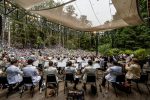REVIEW: SF Symphony pays homage to America at Stern Grove Festival

The San Francisco Symphony, conducted by Edwin Outwater (center), performs at Stern Grove Festival in San Francisco on July 4, 2021. Courtesy.
SAN FRANCISCO — There are very few things more American than jazz, and the San Francisco Symphony took every opportunity to highlight the influences of the American genre on classical music at its Independence Day performance at Stern Grove Festival on Sunday.
From the meditative and somewhat mysterious trumpet-led “Pavanne” from Morton Gould’s “American Symphonette No. 2” (which SF Symphony Conductor Edwin Outwater called “one of my favorite pieces of waiting room music ever written”) and the funky cymbal percussion of Carlos Simon’s “The Block” (which was inspired by the life of a city block in Harlem), to a 15-minute-long original jazz rendition of George Gershwin’s “Rhapsody in Blue,” the performance featured a uniquely zippy vibe.
The symphony musicians, wearing white, were more than 80 members strong for this performance, which was the second performance of this program following Saturday’s show at Davies Symphony Hall. It was the most musicians who had performed together for the orchestra since before the pandemic.
“Hey everybody! We’re back!” Outwater yelled, adding that it was his first time conducting without a facial covering and that the symphony has only recently re-added its brass and woodwind players. He and the orchestra then launched into John Williams’ “Olympic Fanfare and Theme,” an appropriate song choice with the Olympics returning to Japan later this month.
Following Gould’s piece, which included a jazzy trumpet solo by Mark Inouye, Outwater and the SF Symphony detoured into a landscape-inspired piece: Jennifer Higdon’s “Cathedrals,” from “All Things Majestic.” The overall piece was inspired by Grand Teton National Park, but Outwater said the selection performed applied to any nature park. The cacophonous piece had numerous movements rather then a single or a few melodies—meant to convey the many little and big things that one can spot in nature. It was set up with twinkling harp playing and was otherwise string-heavy, though not string-led, lurching ahead like a wild thing.
View this post on Instagram
The orchestra followed that up with two selections (“Saturday Night Waltz” and “Hoedown”) from Aaron Copland’s iconic American composition “Rodeo.” The softer first piece seemed to stop on a dime and pivot to the energized latter one.
The next performance was a newer composition by composer Quinn Mason, who was backstage and came out and took a bow afterward. “Reflections on a Memorial” was a melancholy and at times dirge-like piece, which Outwater explained spoke to the different kinds of loss people suffered during the COVID-19 pandemic
Simon’s upbeat and kinetic “The Block” was a highlight with a piano and brass heartbeat that sometimes resembled a breaking segment on the 6 0’clock news and some jazzy improvisation-like movements.
All that set up the San Francisco Symphony’s signature performance of George Gershwin’s “Rhapsody in Blue,” with virtuoso pianist Aaron Diehl leading the way from a grand piano, his fingers nimbly working the entire length of the instrument.
Outwater gave a brief history of the composition and explained that the orchestra would perform not the pop rendition known by many, but the “punk rock version” originally written by Gershwin as a jazz composition and performed with Paul Whiteman’s orchestra in 1924.
“You’re going to hear some dirty sounds,” Outwater bragged, just before Diehl and the symphony proved him correct.
This version, kicked off by clarinetist Carey Bell, dialed down the orchestral elements and kicked up the jazz, and even some ragtime (a precursor to jazz), to 11. Diehl bided his time at first until letting loose with some nasty piano licks.
After an extended ovation, the orchestra concluded with fireworks playlist classic “Stars and Stripes Forever” (a march by John Philip Sousa) as attendees happily clapped along to the beat.
View this post on Instagram
- Pianist Aaron Diehl performs with the San Francisco Symphony at Stern Grove Festival in San Francisco on July 4, 2021. Courtesy Paige K. Parsons.
- Edwin Outwater conducts the San Francisco Symphony at Stern Grove Festival in San Francisco on July 4, 2021. Courtesy Paige K. Parsons.
- Pianist Aaron Diehl performs with the San Francisco Symphony at Stern Grove Festival in San Francisco on July 4, 2021. Courtesy Paige K. Parsons.
- Pianist Aaron Diehl performs with the San Francisco Symphony at Stern Grove Festival in San Francisco on July 4, 2021. Courtesy Paige K. Parsons.
- The San Francisco Symphony performs at Stern Grove Festival in San Francisco on July 4, 2021. Courtesy Paige K. Parsons.
Follow editor Roman Gokhman at Twitter.com/RomiTheWriter.





